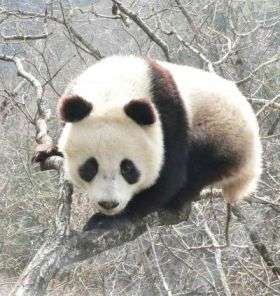January 17, 2017 report
Genetic comparison of giant and red pandas offers clues about convergence

(Phys.org)—A team of researchers at the Chinese Academy of Sciences has conducted a comparison of the genomes of giant and red pandas and has found differences due to adaptive convergence. In their paper published in Proceedings of the National Academy of Sciences, the team describes how they sequenced the genome of a wild red panda and the differences they found when comparing it with the giant panda genome.
Though their names imply that they might be closely related, the giant panda and the red panda are actually very distant cousins. The giant panda is closely related to bears, especially polar bears, while red pandas are more closely related to ferrets. But both species share a common trait—they eat only bamboo (despite being classified as carnivores) and both have developed a false thumb to help them do so. But as this new study shows, the evolutionary changes they underwent to allow them to do so were unconnected. When two or more creatures independently develop similar traits in response to similar environmental conditions, it is known as phenotypic convergence. In this case, two very different types of pandas evolved to have very similar traits.
After sequencing the red panda genome, the researchers compared it to the giant panda and discovered approximately 70 genes related to similar evolutionary changes related to their bamboo-eating lifestyle.
More specifically, they found two genes, PCNT and DYNC2H, that are known to be important in the development of limbs—in the two types of pandas, the changes allowed for extra growth of wrist bones into thumb-like appendages that help with grasping bamboo stalks. The researchers also found other genetic similarities in enzymes in the two species that were involved in getting the most nutritional value out of bamboo. Also identified were 10 similar pseudogenes—genes that cease to serve any function at all and changes to the gene responsible for allowing an animal to taste umami flavor in meat.
The researchers suggest their findings offer insights into the underlying mechanism involved in convergence and adaptation.

More information: Comparative genomics reveals convergent evolution between the bamboo-eating giant and red pandas, Proceedings of the National Academy of Sciences, www.pnas.org/cgi/doi/10.1073/pnas.1613870114
Journal information: Proceedings of the National Academy of Sciences
© 2017 Phys.org




















